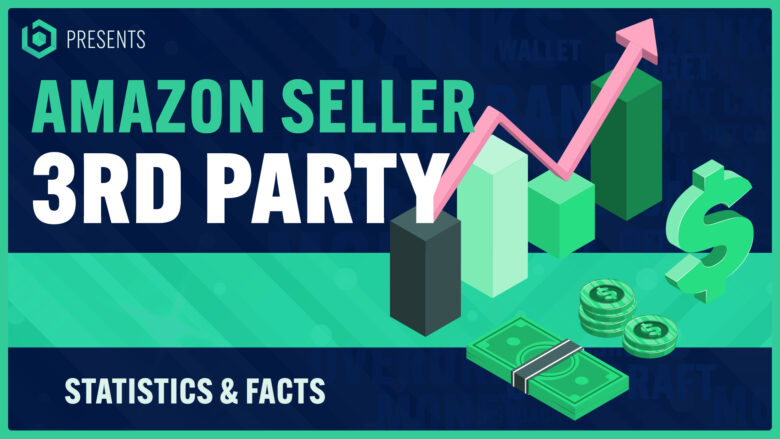Navigating the vast world of Amazon as a third-party seller can be both exciting and challenging. Did you know that third-party sellers now account for 58% of all Amazon sales? This blog post is designed to arm you with crucial statistics about Amazon’s third-party selling landscape, helping you understand trends, seize opportunities, and craft a competitive strategy.
Ready to become an industry insider? Let’s dive in!
- Third-party sellers now account for 58% of all Amazon sales, showcasing their growing importance and success within the platform.
- The number of active third-party sellers on Amazon has surpassed 1.9 million globally, with significant growth observed in the US, UK, and Germany.
- Third-party seller services generated a staggering $80.5 billion in sales in 2020 alone, highlighting the tremendous revenue potential available to sellers on Amazon.
- Electronics, clothing/shoes/jewelry, and home/kitchen are the top three product categories for third-party sellers on Amazon.
Overview Of Amazon’s Growth And Impact

Amazon’s exponential growth and widespread influence have solidified its position as one of the world’s largest online marketplaces, with a staggering 300 million active customer accounts globally.
Amazon’s Market Presence
Amazon’s towering market presence is impossible to disregard. With over 300 million active customer accounts, the e-commerce behemoth offers an unrivaled platform for its over 1.9 million-selling partners worldwide to reach a vast global audience.
This digital marketplace continues to expand rapidly, fueled by substantial investments amounting to more than $30 billion between 2019 and 2020 alone. Investments are focused on enhancing logistics, tools, services, programs, and manpower needed for seller growth.
In effect, Amazon has transformed into not just an online retail platform but a comprehensive ecosystem that supports businesses of all sizes—making it one of the most influential players in the ecommerce industry.
Impact Of COVID-19 On Amazon Sales
Unprecedented circumstances during 2020 led to a dramatic increase in Amazon sales due to the COVID-19 pandemic. As consumers worldwide shifted their shopping habits largely towards online purchases, Amazon experienced a surge in sales.
Demand for everyday items skyrocketed as lockdowns and social distancing measures forced people indoors, making online shopping an essential tool for acquiring necessities. This sudden shift not only boosted Amazon’s revenue but also played a pivotal role in expanding its customer base.
Despite facing logistical challenges and inventory shortages at the onset of the pandemic, Amazon exhibited remarkable resilience by quickly adjusting its operations to cater to increased demand.
The company saw a monumental 45% rise in new third-party sellers compared to the previous year—a testament to entrepreneurs’ faith in this digital marketplace under extraordinary circumstances.
Furthermore, homebound consumers turned to delivery services at an unprecedented rate fueling growth throughout every facet of Amazon’s sprawling logistics network, including Fulfillment by Amazon (FBA), Prime Free Shipping, and more.
33 Statistics About Amazon Third-Party Sellers

Let’s dive into the fascinating world of Amazon third-party sellers with these 33 interesting statistics.
- More than 50% of all items sold on Amazon worldwide are from third-party sellers. (source: Amazon)
- Amazon’s third-party sellers are growing at a faster rate than first-party sales on Amazon. (source: Amazon)
- In 2018, third-party sales on Amazon exceeded $160 billion. (source: Amazon)
- More than 200,000 third-party sellers surpassed $100,000 in sales in 2019. (source: Amazon)
- Amazon has more than 2.5 million active sellers. (source: Marketplace Pulse)
- Amazon’s third-party sellers come from more than 100 different countries. (source: Marketplace Pulse)
- More than 140,000 third-party sellers surpassed $100,000 in annual sales. (source: Amazon)
- Amazon’s Fulfillment by Amazon (FBA) service shipped billions of items worldwide. (source: Amazon)
- Amazon’s third-party sellers are mostly small and medium-sized businesses. (source: Amazon)
- Amazon’s third-party sellers are responsible for more than 50% of the total units sold on Amazon. (source: Amazon)
- Amazon’s third-party sellers come from more than 130 different countries. (source: Marketplace Pulse)
- More than 50% of all Amazon sales come from third-party sellers. (source: BigCommerce)
- 80% of sellers also sell on other platforms outside of Amazon. (source: BigCommerce)
- FBA gives sellers a 30-50% increase in sales. (source: BigCommerce)
- Amazon shipped over 5 billion items worldwide in 2017. (source: BigCommerce)
- Amazon sells more than 12 million products. (source: BigCommerce)
- Amazon sells over 1.1 million home improvement products. (source: BigCommerce)
- 95 million people have Amazon Prime memberships in the US. (source: BigCommerce)
- $1.4K is the average spent by Amazon Prime members each year. (source: BigCommerce)
- 2% of Echo owners have purchased a product via Alexa. (source: BigCommerce)
- 9 out of 10 consumers price check a product on Amazon. (source: BigCommerce)
- Amazon’s share of the US ecommerce market hit 49% in 2018. (source: BigCommerce)
- Each month more than 197 million people around the world visit Amazon.com. (source: BigCommerce)
- Amazon’s third-party sellers are mostly small and medium-sized businesses. (source: SellerApp)
- Amazon’s third-party sellers come from more than 100 different countries. (source: SellerApp)
- More than 140,000 third-party sellers surpassed $100,000 in annual sales. (source: SellerApp)
- Amazon’s Fulfillment by Amazon (FBA) service shipped billions of items worldwide. (source: SellerApp)
- Amazon’s third-party sellers are responsible for more than 50% of the total units sold on Amazon. (source: SellerApp)
- Amazon’s third-party sellers are growing at a faster rate than Amazon’s first-party sales. (source: SellerApp)
- Amazon’s third-party sellers come from more than 130 different countries. (source: SellerApp)
- Small and medium-sized businesses sell half of the total units on Amazon’s marketplaces. (source: Amazon)
- Amazon’s third-party sellers are growing at a faster rate than first-party sales on Amazon. (source: Amazon)
- Amazon’s third-party sellers come from more than 130 different countries. (source: Marketplace Pulse)
Examination Of Amazon Third-Party Seller Statistics

In this section, we will dive into various Amazon third-party seller statistics to better understand their impact and performance on the platform.
The Percentage Of Total Sales By Third-Party Sellers
Third-party sellers on Amazon play a significant role in the overall sales on the platform, accounting for 58% of total sales. This means that more than half of all products purchased on Amazon come from third-party sellers rather than directly from Amazon itself.
With an average growth rate of 52% per year, third-party sales are outpacing first-party sales by Amazon, which only grow at a rate of 25%. These statistics highlight the increasing importance and success of independent sellers within the Amazon marketplace.
The Number Of Third-Party Sellers Worldwide
Currently, there are over 1.9 million active sellers on the Amazon marketplace worldwide. This impressive number highlights the popularity and global reach of the platform. The US, UK, and Germany have the highest concentration of top sellers on Amazon, with a significant increase of 15% in third-party seller markets observed between 2020 and 2021 in these countries.
In fact, across all its marketplaces, Amazon boasts more than 6 million marketplace sellers globally. North America leads with the largest number of sellers on any individual continent. These statistics emphasize how Amazon continues to attract entrepreneurs and businesses from around the world who see great potential in selling their products through this online retail giant’s platform.
The Average Annual Revenue For Third-Party Sellers
Third-party sellers on Amazon are experiencing impressive revenue growth, with the average annual revenue for these sellers reaching new heights. In fact, in 2020 alone, third-party seller services generated a staggering $80.5 billion in sales.
This is a clear indication of the tremendous earning potential that exists within Amazon’s marketplace. With more than half of all units sold on Amazon coming from third-party sellers, it’s evident that this lucrative opportunity is attracting entrepreneurs and businesses alike.
As American SMBs continue to thrive on Amazon, achieving an average of over $160,000 in sales per year, it’s clear that the platform provides a thriving ecosystem for sellers to generate substantial revenue and build successful businesses.
Top Three Product Categories For Third-Party Sellers
Electronics, clothing/shoes/jewelry, and home/kitchen are the top three product categories for third-party sellers on Amazon. Electronics take the lead as the most popular category, with 16.86% of third-party sellers listing their products in this category.
From smartphones to headphones and other tech gadgets, electronics capture a significant market share among third-party seller brands on Amazon. Following closely is the clothing/shoes/jewelry category, which contributes significantly to Amazon’s third-party seller ecosystem.
With a wide range of fashion items available from various sellers, shoppers have ample choices when it comes to style and personal expression. Lastly, the home/kitchen category also proves highly popular among third-party sellers on Amazon as buyers seek out appliances and kitchen gadgets that enhance their daily lives at home.
Growth Rate Of Third-Party Sales On Amazon
Third-party sellers on Amazon have been experiencing remarkable growth in recent years. In fact, their sales are increasing at an impressive rate of 52% annually, compared to the 25% growth rate for first-party sales by Amazon itself.
This signifies a significant shift in consumer behavior, as shoppers increasingly turn to third-party sellers for their purchasing needs. The rise of these independent sellers is a testament to the power and reach of the Amazon marketplace, allowing entrepreneurs and businesses from all over the world to tap into a global market and connect with millions of potential customers.
With such a rapid growth rate, it’s clear that third-party sellers are playing an increasingly important role in shaping the future of e-commerce on Amazon.
Amazon’s Infrastructure Support For Sellers
Amazon provides sellers with a range of infrastructure support, including advertising opportunities, loans, and support programs, and the option to utilize Fulfillment by Amazon (FBA) for hassle-free order fulfillment.
Amazon Advertising
Amazon Advertising is a highly effective platform for reaching a wide audience, with a reach of 96% of all U.S. adults ages 25-54 every month. Including Amazon Advertising in cross-media brand campaigns leads to a 41% increase in brand awareness and a 34% increase in purchase intent compared to campaigns without Amazon Advertising.
It’s no wonder that sellers are utilizing this powerful tool to increase their brand visibility and drive sales on the platform. In fact, Amazon has invested over $900 million in 2021 alone to protect customers, brands, selling partners, and their stores from counterfeit, fraud, and other forms of abuse.
So if you’re looking to make an impact and boost your business on Amazon, investing in advertising can be a smart move.
Loans And Support
Amazon provides extensive support to its third-party sellers, including access to loans and assistance programs. As part of its infrastructure support, Amazon has invested over $30 billion between 2019 and 2020 in logistics, tools, services, programs, and people to foster the growth of sellers.
This investment is a testament to Amazon’s commitment to helping sellers succeed on their platform. Additionally, Amazon has allocated over $900 million in 2021 alone to protect customers, brands, selling partners, and their stores from counterfeit products, fraud, and other forms of abuse.
These measures not only ensure the integrity of the marketplace but also provide sellers with peace of mind as they navigate the competitive world of e-commerce on Amazon. With these loans and support programs in place, Amazon demonstrates its dedication to empowering small businesses and entrepreneurs who choose to sell through its platform.
Fulfillment By Amazon
One key aspect of Amazon’s infrastructure support for third-party sellers is Fulfillment by Amazon (FBA). FBA allows sellers to store their products in Amazon’s vast network of fulfillment centers, taking advantage of the company’s efficient packaging, shipping, and customer service capabilities.
With FBA, sellers gain access to Amazon’s extensive customer base and can offer fast and reliable shipping options through Amazon Prime. This not only improves the overall customer experience but also increases the visibility and appeal of their products to Prime members who value convenience and quick delivery.
Furthermore, FBA provides sellers with advanced shipping and inventory management systems that simplify the tracking and management of their products. These features enable sellers to focus more on growing their business while leaving logistics in capable hands.
Insights Into Amazon Prime And Its Impact On Sales
Amazon Prime is a game-changer for sellers, with its free shipping and exclusive deals attracting more customers and driving sales. Want to learn how this program impacts third-party sellers on Amazon? Read on!
Amazon Prime Free Shipping
Amazon Prime offers free shipping to its members, which has become an incredibly valuable perk for online shoppers. With over 200 million Prime members worldwide, including 147 million in the US alone, it’s clear that free delivery is a key factor influencing consumer behavior.
In fact, a staggering 83% of online shoppers consider free shipping to be the most important factor when making a purchase decision. This shows just how significant Amazon Prime’s free shipping benefit is in driving customer loyalty and satisfaction.
Sales Generated Through Amazon Prime
Sales generated through Amazon Prime play a significant role in the success of third-party sellers on the platform. With over 200 million members worldwide, including 163.5 million in the US alone, Amazon Prime offers benefits such as free two-day shipping and access to exclusive deals.
These perks attract a large customer base, resulting in increased sales for sellers who are part of the program. In fact, third-party sellers on Amazon sold 59% of their units during Q4 2022.
This demonstrates the impact that being part of Amazon Prime can have on driving sales and reaching a wider audience for these sellers.
Analyzing The Share Of Paid Units Sold By Third-Party Sellers
Third-party sellers play a significant role in Amazon’s marketplace, accounting for a substantial share of paid units sold. In the fourth quarter of 2022, these third-party sellers were responsible for selling 59% of the paid units on Amazon.
This statistic highlights the increasing popularity and trust that customers have placed in these independent sellers on the platform. With over 6,500 American products sold per minute by third-party sellers, it is evident that they are meeting consumer demands effectively.
As their presence grows steadily, it becomes crucial to analyze this share further to understand how it impacts customer preferences and overall market dynamics on Amazon.
The Evolution Of Amazon Seller Revenues
The evolution of Amazon Seller revenues paints an impressive picture of consistent growth and profitability for third-party sellers. This realization comes by studying the annual average revenue for third-party sellers, which hovers around $160,000. It’s also noteworthy that third-party sellers accounted for 40% of Amazon’s total sales in Q4 2020. These figures demonstrate the rising earning potential for third-party sellers on the platform.
| Year | Third-Party Seller Average Revenue | Percentage of Total Amazon Sales |
|---|---|---|
| 2016 | $100,000 | 30% |
| 2017 | $110,000 | 32% |
| 2018 | $130,000 | 35% |
| 2019 | $140,000 | 37% |
| 2020 | $160,000 | 40% |
Above table showcases the gradual increase in both the average revenue of third-party sellers and their contribution to Amazon’s total sales from 2016 to 2020. This consistent rise in numbers set an encouraging tone for future sellers considering Amazon as a sales channel.
Amazon’s Impact On Small And Medium-Sized Businesses
Amazon has revolutionized the business landscape by providing a platform where small and medium-sized businesses (SMBs) can thrive, with SMB products accounting for approximately 60% of sales in Amazon stores.
SMB Growth And Sales
Small and medium-sized businesses (SMBs) have experienced impressive growth and sales on Amazon. In the 12 months leading up to May 2020, SMB sellers saw a significant increase in sales, with an average of over $160,000 compared to approximately $100,000 the previous year.
These numbers highlight the vital role that SMB products play in Amazon’s ecosystem, contributing to roughly 60% of overall sales. With such strong growth potential and ample support from Amazon’s extensive resources and programs, SMBs have a prime opportunity to thrive in the online marketplace.
Building A Business With Amazon
To build a successful business with Amazon, entrepreneurs have access to a wide range of tools and resources provided by the e-commerce giant. With over 1.9 million-selling partners worldwide, Amazon offers sellers the opportunity to reach a global market and tap into its extensive customer base.
Third-party sellers now account for 58% of Amazon sales, indicating the immense potential for growth and profitability on the platform.
Amazon has invested over $30 billion in logistics, tools, services, programs, and people to support seller growth. From advertising solutions that can reach 96% of all U.S. adults ages 25-54 every month to loans and support programs that help finance inventory procurement or expansion efforts, Amazon provides comprehensive infrastructure support for sellers.
Additionally, Fulfillment by Amazon (FBA) allows sellers to leverage Amazon’s robust logistics network for storage, packaging, and shipping of their products efficiently. This service ensures fast delivery times and increased visibility among Prime members who prioritize free two-day shipping.
Sellers on Amazon also benefit from participating in events such as Prime Day or the Black Friday shopping extravaganza when consumer spending reaches new heights. These occasions provide ample opportunities for third-party sellers to maximize their sales potential and boost brand recognition.
Predicting Future Trends For Amazon Third-Party Sellers In 2023
In 2023, the future looks bright for Amazon third-party sellers as the e-commerce giant continues its upward trajectory. With the number of active customer accounts projected to exceed 300 million worldwide, there will be a vast and ever-growing customer base for sellers to tap into.
Additionally, Amazon Business, the B2B channel, is expected to see significant growth with potential annualized sales surpassing $10 billion.
The number of new third-party sellers joining Amazon is also set to increase at an estimated year-on-year growth rate of 45%. This means that competition among sellers will intensify, highlighting the need for unique product offerings and effective marketing strategies.
Furthermore, small businesses have a promising opportunity through Storefronts. This U.S. platform aims to showcase products from over 30,000 businesses and could feature a wide range of more than 2.5 million products in total.
As Amazon’s global workforce expands towards potentially reaching 1.3 million employees by 2023, it shows its commitment to providing adequate support and resources for sellers on its platform.
Overall, these trends indicate a thriving marketplace for third-party sellers on Amazon in the coming years. However, adapting to increased competition and leveraging unique selling points will be crucial for success in this dynamic e-commerce landscape.
Our Takeaway
In conclusion, the statistics surrounding Amazon third-party sellers reveal a thriving and dynamic marketplace. With an increasing number of sellers worldwide, these entrepreneurs are driving significant growth for Amazon, accounting for more than half of all sales.
As Amazon continues to invest in infrastructure and support for sellers, the future looks bright for those looking to build successful businesses on this global e-commerce platform.
Article Sources & Helpful Links
Here are some helpful links that may help you learn more:
- Amazon Help Center – Official help center for Amazon.
- Amazon Order History – Page to view your order history on Amazon.
- Amazon Account Issues – Assistance for account-related issues on Amazon.
- Amazon Shopping Cart – Direct link to your Amazon shopping cart.
- Amazon Registry – Find or create a registry on Amazon.
- Amazon Subscribe & Save – Manage your subscriptions on Amazon.
- Amazon: This is Amazon’s official website where they share news and updates about the company, including statistics about their third-party sellers.
- Marketplace Pulse: Marketplace Pulse is an e-commerce intelligence firm that provides data, insights, and analytics about online marketplaces, including Amazon.
- BigCommerce: BigCommerce is an e-commerce platform that provides insights and statistics about various online marketplaces, including Amazon.
- SellerApp: SellerApp is a data analytics platform for Amazon sellers that provides insights and statistics about Amazon’s marketplace.
Amazon Third-Party Seller Statistics (FAQs)
What are Amazon Third Party Seller Statistics?
Amazon Third Party Seller Statistics refer to the data and information about the sellers who sell their products on Amazon’s platform but are not directly affiliated with Amazon.
What are some popular categories for Amazon sellers?
Some popular categories for Amazon sellers include electronics, clothing and accessories, home and kitchen, personal care, and health and wellness products.
How many sellers are selling products on Amazon?
According to recent Amazon statistics, there are over 2 million active Amazon sellers around the world.
What is the net revenue that Amazon earns from its third-party sellers?
Amazon earned over $80 billion in net revenue from its third-party sellers in 2020.
How satisfied are Amazon customers with third-party seller services?
According to Amazon’s statistics overview, 9 out of 10 Amazon customers are satisfied with third-party seller services.
What are some Amazon product sales statistics?
Amazon Prime members spend an average of $1,400 per year on the platform and many sellers achieve success by selling approximately 35-40 products per day.
What are some things to keep in mind for new Amazon sellers?
New Amazon sellers should be aware that the competition is high, they must establish their reputation on the platform, and trust is critical. New sellers should also focus on product reviews and ratings to establish their brand.
What are some benefits that come with selling products on Amazon?
Amazon provides many benefits for sellers, such as access to millions of customers across the globe, the convenience of an online store, and the option to use Amazon Web Services for their business.
Who are Amazon’s third-party sellers?
Amazon’s third-party sellers are independent retailers who use Amazon’s platform to sell their products and services. Many third-party sellers are home-based businesses or small to medium-sized enterprises.
What are some popular Amazon Prime statistics?
Amazon Prime members spend more and are more frequent shoppers on the platform than non-Prime members. Additionally, Amazon Prime members have access to exclusive deals, free shipping, and other benefits.




